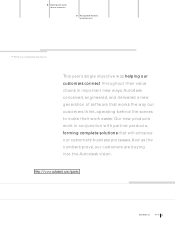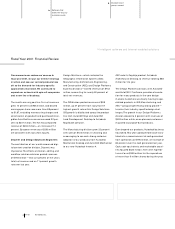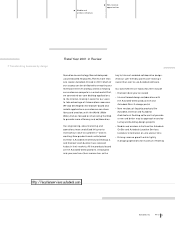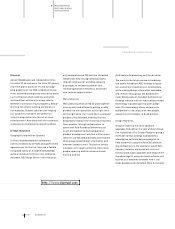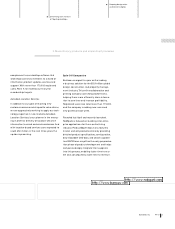Autodesk 2001 Annual Report Download - page 16
Download and view the complete annual report
Please find page 16 of the 2001 Autodesk annual report below. You can navigate through the pages in the report by either clicking on the pages listed below, or by using the keyword search tool below to find specific information within the annual report.
13
Autodesk, Inc. FY 01
Competition
We compete with different companies in each of our
product groups.
The software industry has limited barriers to entry, and the
availability of desktop computers with continually
expanding capabilities at progressively lower prices con-
tributes to the ease of market entry. Since customers
increasingly rely on the Internet, new platforms and tech-
nologies can be expected to be developed in the design
industries. The design software market in particular is
characterized by vigorous competition in each of the ver-
tical markets in which we compete, both by entry of
competitors with innovative technologies and by consoli-
dation of companies with complementary products and
technologies. In addition, the availability of third-party
application software is a competitive factor within the CAD
market. Because of these and other factors, competitive
conditions in the industry are likely to intensify in the future.
Increased competition could result in price reductions,
reduced net revenues and profit margins and loss of market
share, any of which could harm our business. Furthermore,
some of our competitors have greater financial, technical,
sales and marketing and other resources.
We believe that our future results depend largely upon our
ability to offer new products, and to continue to provide
existing product offerings, that compete favorably with
respect to reliability, performance, ease of use, range of
useful features, continuing product enhancements, repu-
tation, price and training.
Intellectual Property and Licenses
We protect our intellectual property through copyright,
trade secret, patent and trademark laws, confidentiality
procedures and contractual provisions. Nonetheless, our
intellectual property rights may not be successfully
asserted in the future or may be invalidated, circumvented
or challenged. In addition, the laws of various foreign
countries where our products are distributed do not pro-
tect our intellectual property rights to the same extent as
U.S. laws. Our inability to protect our proprietary informa-
tion could harm our business.
From time to time, we receive claims alleging infringe-
ment of a third party’s intellectual property rights,
including patents. Any disputes involving our intellectual
property rights or those of another party could lead to
costly litigation and possibly result in our loss of signifi-
cant rights, which could harm our business.
We retain ownership of software we develop. All software
is licensed to users and provided in object code pursuant
to either shrink-wrap, embedded or on-line licenses, or
executed license agreements. These agreements contain
restrictions on duplication, disclosure and transfer.
We believe that because of the limitations of laws protect-
ing our intellectual property and the rapid, ongoing
technological changes in both the computer hardware
and software industries, we must rely principally upon
software engineering and marketing skills to maintain and
enhance our competitive market position.
While we have recovered some revenues resulting from
the unauthorized use of our software products, we are
unable to measure the extent to which piracy of our soft-
ware products exists. Software piracy can be expected to
be a persistent problem.
Production and Suppliers
Production of our software products involves duplication
of the software media and the printing of user manuals.
The purchase of media and the transfer of the software
programs onto media for distribution to customers are
performed by us and by licensed subcontractors. Media
for our products include CD-ROMs and diskettes, which
are available from multiple sources. User manuals for our
products and packaging materials are produced to our
specifications by outside sources. Domestic production is
performed in leased facilities operated by us. Some prod-
uct assembly is also performed by independent
third-party contractors. International production is per-
formed by independent third-party contractors in Ireland
and Singapore. To date, we have not experienced any
material difficulties or delays in the production of our soft-
ware and documentation.
The Discreet Division has historically relied on third-party
vendors to manufacture and supply all of the hardware
components used in its systems. Manufacturing consists
of assembly (including disk array assembly), testing, and
value added systems integration. Many of the Discreet
Division’s software products currently run on workstations
manufactured by Silicon Graphics. Additionally, the
Discreet Division is dependent on Silicon Graphics as the
main source for video input/output cards used in the sys-
tems. There are significant risks associated with this
reliance on Silicon Graphics and the Discreet Division may
be impacted by unforeseen difficulties associated with
adapting their products to future Silicon Graphics prod-
ucts and the timing of the development and release of
Silicon Graphics products.


